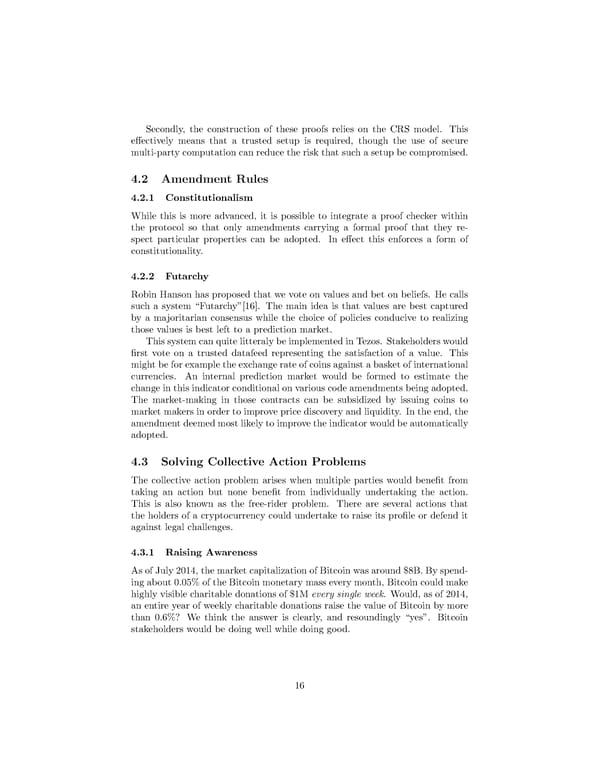Secondly, the construction of these proofs relies on the CRS model. This effectively means that a trusted setup is required, though the use of secure multi-party computation can reduce the risk that such a setup be compromised. 4.2 Amendment Rules 4.2.1 Constitutionalism While this is more advanced, it is possible to integrate a proof checker within the protocol so that only amendments carrying a formal proof that they re- spect particular properties can be adopted. In effect this enforces a form of constitutionality. 4.2.2 Futarchy Robin Hanson has proposed that we vote on values and bet on beliefs. He calls such a system “Futarchy”[16]. The main idea is that values are best captured by a majoritarian consensus while the choice of policies conducive to realizing those values is best left to a prediction market. This system can quite litteraly be implemented in Tezos. Stakeholders would first vote on a trusted datafeed representing the satisfaction of a value. This might be for example the exchange rate of coins against a basket of international currencies. An internal prediction market would be formed to estimate the change in this indicator conditional on various code amendments being adopted. The market-making in those contracts can be subsidized by issuing coins to market makers in order to improve price discovery and liquidity. In the end, the amendmentdeemedmostlikelytoimprovetheindicatorwouldbeautomatically adopted. 4.3 Solving Collective Action Problems The collective action problem arises when multiple parties would benefit from taking an action but none benefit from individually undertaking the action. This is also known as the free-rider problem. There are several actions that the holders of a cryptocurrency could undertake to raise its profile or defend it against legal challenges. 4.3.1 Raising Awareness AsofJuly2014, the market capitalization of Bitcoin was around $8B. By spend- ing about 0.05% of the Bitcoin monetary mass every month, Bitcoin could make highly visible charitable donations of $1M every single week. Would, as of 2014, an entire year of weekly charitable donations raise the value of Bitcoin by more than 0.6%? We think the answer is clearly, and resoundingly “yes”. Bitcoin stakeholders would be doing well while doing good. 16
 A Self-Amending Crypto-Ledger Position Paper Page 17 Page 19
A Self-Amending Crypto-Ledger Position Paper Page 17 Page 19